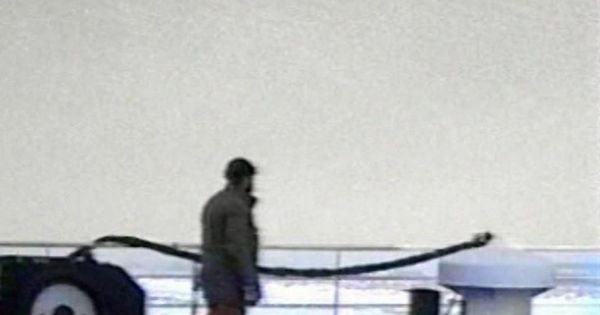Eye For Film >> Movies >> Vikingland (2011) Film Review
Vikingland
Reviewed by: Rebecca Naughten

Vikingland is found-footage film made up of diary-like material shot in the winter of 1993-1994 by Luis Lomba, a sailor from Galicia who was working on the Romo (Denmark) to Sylt (Germany) ferry and decided to make a record of his life onboard using a video camera. Among Lomba's crew mates was the father of Xurxo Chirro - the director discovered copies of the footage on tapes marked 'Vikingland' some 15 years or so later and saw the potential for a film. The result bridges documentary and fiction, and encompasses emigration, identity, labour, and those whose lives are buffeted by economic forces beyond their control.
Because he didn't shoot the material, Chirro classes himself as the 'manipulator' of Vikingland rather than its director - he shaped the footage around the structure of Herman Melville's Moby Dick, dividing the film into chapters with titles evoking the novel ('Crew', 'Luis', 'Cold', 'Christmas', 'Vikingland', 'Work', 'Passages', 'Deck', 'Ice', 'Whiteness', and 'Epilogue'). Although the material is not edited in precise chronological order, there is nonetheless a sense of progression in terms of a winter worsening and a gradual degradation of the images - the sound disappears, the colour desaturates to virtual black and white, and eventually the image pixellates and fragments in a way not dissimilar to the broken ice through which the ship pushes.

From the outset, Luis plays with the camera, changing screen ratios (possibly accidentally), zooming in and out, panning, and generally exploring its functionality with a remote control. He anxiously fusses over the positioning of the camera when he is not holding it - at one point it goes AWOL when the trolley it's sitting on rolls away across the deck - and in the group scenes (dinnertimes or relaxation) the camera is often connected to an off-screen television meaning that the men are watching instant playback of themselves and adjust their body language accordingly. There is a fascinating delineation of public and private personas, but Luis evidently expected the footage to be watched by others - he winks at, and talks to, the camera when he is on his own.
The nature of identity is questioned not only in Luis's self-conscious performances of himself for the camera, but also in the way that his being abroad emphasises the markers of his cultural identity. This is manifested in the way he switches between languages depending on who he is talking to, moments such as an offhand comment about vinegary fruit ("They don't know how to grow oranges here"), or more notably the Christmas meal with those of his fellow Galicians among the sailors (where the conversation turns from a wish to show people at home what their life at sea is like, to the desire to be home because "the thing is being there"). Of course, in being on a ferry, Luis and his colleagues frequently are neither in one fixed space or another - they are adrift in the interstices on the ice floes.
As the repetition of routine accrues and dead time accumulates, the space between Luis and the camera also increases - we start by meeting people on their downtime (when Luis is often holding the camera), move on to them working (when the camera is stationary but he often moves to adjust its position), and then contemplate the horizon as the ferry travels back and forth (when he is unable to return to the camera because of the nature of the work he is doing). As the sound breaks down in the final sections and we are left with images lit in an otherworldly hue due to the combination of light, ice and the video's desaturated colour, the viewer accompanies Luis on a journey into fatigued introspection as he's faced with a vast white nothingness between him and the curve of the horizon - silently making the most overt connection to Melville's novel, specifically Ismael's contemplation of the significance of whiteness.
Vikingland is a hybrid beast, as befits its birth - it combines the highly-personal and self-conscious aspects of a diary film with a distancing effect created by the literary manner of Chirro's arrangement of the material. Dedicated 'to the Galician sailors', it is also an acknowledgement and record of those who are compelled by economic necessity to leave their home, and the travails of trying to carry traces of it with you.
Reviewed on: 17 May 2015















